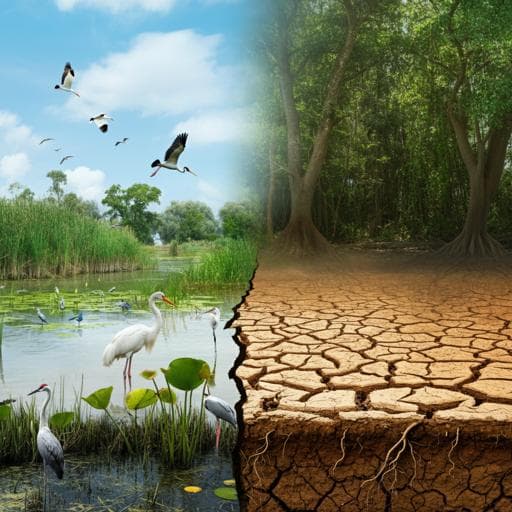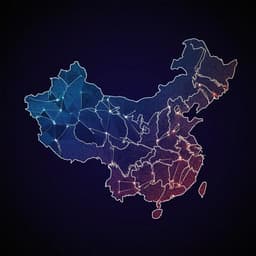
Environmental Studies and Forestry
Trade-off between tree planting and wetland conservation in China
Y. Xi, S. Peng, et al.
This study reveals how tree planting in China from 2000 to 2016 has led to significant wetland loss, particularly in the dry northern and western regions. Researchers Yi Xi, Shushi Peng, Gang Liu, Agnès Ducharne, Philippe Ciais, Catherine Prigent, Xinyu Li, and Xutao Tang underscore the importance of spatially optimizing tree planting efforts to protect vulnerable wetland areas while still enhancing carbon sequestration.
~3 min • Beginner • English
Introduction
China has implemented large-scale afforestation and forest protection programs over the last four decades to enhance ecological services and support land-system sustainability (e.g., Three-North Shelterbelt, Natural Forest Conservation, Grain for Green). Forest area increased by ~50% relative to the 1980s, predominantly through plantations. While afforestation has reduced soil erosion, dust storms, and desertification, studies show increased evapotranspiration (ET) and reduced runoff (Q) and soil moisture (SM), especially in northern drylands. Reduced catchment water availability can diminish water inflow to wetlands, threatening biodiversity, water security, climate regulation, and cultural values. With China targeting 26% forest coverage by 2035, the study asks where and to what extent tree planting threatens wetland conservation, quantifies historical (2000–2016) impacts, and projects near-term (2017–2035) outcomes to inform trade-offs and spatial optimization between afforestation and wetland protection.
Literature Review
Prior work has documented both benefits and hydrological costs of afforestation in China, including increased ET and reduced runoff and soil moisture in drylands. Conceptual hydrological frameworks (Budyko) and paired watershed studies have shown that vegetation changes alter water yield, with effects varying by climate zone, species, forest age, and management. Global studies have also highlighted hydrological legacies of deforestation on wetlands and uncertainties in coupled climate-hydrology feedbacks. These strands motivate assessing how afforestation may trade off with wetland conservation, particularly under China’s ambitious forest expansion plans.
Methodology
Data and models: The study combines satellite inundation data (GIEMS-2, 0.25° monthly, 2000–2015) with the ORCHIDEE-Hillslope land surface model (r6515; 0.5°) to simulate carbon-water processes and hillslope hydrology, producing soil moisture (SM). A TOPMODEL-based diagnostic approach (DYPTOP implementation) translates SM deficits into subgrid wetland (flooded) fractions. Wetland model parameters were calibrated against the static high-resolution Regularly Flooded Wetlands (RFW) map and the annual maximum wetland area from GIEMS-2, after removing rice paddies (HYDE v3.2) to focus on natural wetlands.
Historical simulations (2000–2016): Two factorial runs isolate forest change effects: S1 (with climate change, elevated CO2, and observed forest cover change from National Forest Inventory-derived annual maps) and S0 (same forcing but fixed 2000 land cover). Climate forcing is GSWP3-W5E5; CO2 follows NOAA observations. A 200-year spin-up precedes transient runs. In parallel, a Budyko conceptual framework estimates changes in Q due to vegetation shifts (forest vs grass parameter w), providing a benchmark for modelled ET/Q responses.
Sensitivity decomposition: The sensitivity of wetland area change to forest area change (ΔAwet/ΔAforest) is decomposed into the product of wetland sensitivity to SM (ΔAwet/ΔSM) and SM sensitivity to forest change (ΔSM/ΔAforest) across climate zones defined by PET/P.
Protected wetlands: Wetland nature reserves (national, provincial, municipal/county) were intersected with HydroBASINS level 6 units to evaluate basin-scale impacts of afforestation on protected wetlands.
Near-term scenarios (2017–2035): Four tree-planting scenarios assess location dependence under constant 2000–2016 climate variability: SA (afforestation follows recent historical spatial trajectory); Sdry (all new trees placed in dry zones PET/P>2); Smesic (PET/P 1–2); Swet (PET/P<1). Additional runs (SB) use ISIMIP3b near-term climate projections (SSP1-2.6, SSP3-7.0, SSP5-8.5; five GCMs each) with the SA land-cover trajectory to test whether climate changes offset afforestation-induced wetland loss. Wetland fractions are simulated monthly and aggregated to areas for analysis.
Key Findings
- Historical afforestation and wetlands (2000–2016): Of ~0.33 Mkm² national afforestation, 0.19 Mkm² occurred over wetland grid cells, causing an estimated net wetland loss of 1,300–1,500 km² (−0.3% to −0.4% of total wetland area). Losses concentrated in northern and northeastern China; some grid cells showed wetland loss rates >0.04% yr⁻¹, despite similar or larger forest gains in southern China.
- Hydrological changes: Budyko estimates indicate annual runoff (Q) decreased by 0.8–2.4 mm yr⁻² at the grid scale and 0.15–0.9 mm yr⁻² at the catchment scale in regions with substantial forest gains; normalized δQ/P impacts are strongest for PET/P≈0.6–2.2. ORCHIDEE-Hillslope simulations agree on decreasing Q and show a significant SM decline due to afforestation (mean trend −0.15 mm yr⁻¹, p<0.05), especially in NE, N, SW China.
- Sensitivity by climate zone: Wetland loss per 1 km² forest gain (ΔAwet/ΔAforest) is highest in dry regions (PET/P>2), reaching 0.005–0.10 km² km⁻² in parts of northern/northeastern China, and negligible in wet southern areas (PET/P<1). The climate-zone pattern is mainly driven by more negative ΔSM/ΔAforest in drier zones.
- Protected wetlands: Protected basins cover ~35% of China (~3.31 Mkm²) but hold ~43% of forest area (~0.69 Mkm²) and ~46% of wetland extent (~0.30 Mkm², RFW). With ~0.08 Mkm² forest increase, protected basins accounted for ~800 km² wetland loss (~53% of national wetland loss). Sensitivities (ΔAwet/ΔAforest): National reserves (BASN) −0.018 km² km⁻² vs provincial −0.010 and municipal/county −0.009. Small adjustments to historical afforestation (~10 km² fewer in BASN; ~40 km² fewer across all protected basins) could have prevented >10% wetland loss in 2/39 BASN and 8/144 protected basins.
- Near-term projections (2017–2035): Under the historical-trajectory scenario (SA), 0.22 Mkm² new planting in wetland grid cells leads to ~1,300 km² additional wetland loss; ~11% of wetland grid cells exceed 10% loss relative to 2000. Extreme location scenarios yield stark contrasts: Sdry (PET/P>2) adds 0.16 Mkm² over wetland grids but causes ~1,800 km² wetland loss; Smesic (1–2) adds 0.18 Mkm² with ~1,600 km² loss; Swet (<1) adds 0.32 Mkm² with only ~200 km² loss.
- Climate change effects: ISIMIP3b projects small precipitation changes by 2035 (−11 to +12 mm yr⁻¹, <2%). Resulting wetland trends with climate change alone are insignificant (−300 to +80 km² yr⁻¹). Afforestation under all SSPs still yields a significant net wetland loss of ~1,200–1,300 km² by 2035, indicating that projected precipitation changes will not offset afforestation-induced wetland reductions.
- Spatial optimization: Afforestation in wet zones causes minimal wetland loss even with larger forest expansions; concentrating planting in dry/mesic zones maximizes wetland impacts. Targeted siting can substantially mitigate trade-offs.
Discussion
The study demonstrates that while China’s afforestation since 2000 produced only a modest national-scale wetland loss, impacts are highly heterogeneous and concentrated in dry northern and northeastern regions, where increased ET and reduced SM/Q strongly curtail wetland extent. Protected wetlands are disproportionately located in these sensitive regions, elevating conservation risks under continued tree planting. Projections show that near-term afforestation will likely continue to erode wetlands regardless of modest precipitation changes expected under different SSPs. These findings address the central question of where and to what extent afforestation threatens wetlands, emphasizing that siting afforestation in wet climates or away from wetland-influencing catchments can substantially reduce negative outcomes. The results underscore the importance of integrating hydrological sensitivity and protection status into afforestation planning to balance carbon sequestration goals with wetland conservation and associated ecosystem services.
Conclusion
This work quantifies historical and near-term trade-offs between afforestation and wetland conservation in China by combining satellite inundation data, land surface modeling with hillslope hydrology, and a diagnostic wetland scheme. Key contributions include mapping climate-dependent sensitivities, demonstrating disproportionate risks for protected wetlands in dry regions, and showing that spatial targeting of afforestation can significantly mitigate wetland losses. Policymakers can reduce trade-offs by prioritizing planting in wet zones or catchments with low wetland sensitivity, and by limiting planting in basins hosting protected wetlands. Future research should refine coupled land–atmosphere feedbacks of afforestation, incorporate species/age/management effects on water yield, and evaluate multi-objective optimization across carbon, biodiversity, hydrology, and cultural services.
Limitations
- Land–atmosphere feedbacks of afforestation (e.g., precipitation changes induced by forest cover) were not fully represented; such feedbacks could partly mitigate wetland losses in some regions.
- Uncertainties in climate model projections (precipitation) and hydrological responses persist.
- Model structural limitations: species composition, stand age, and management practices that influence water yield are not explicitly represented.
- Wetland datasets (GIEMS-2, RFW) have resolution and detection limitations (e.g., small water bodies, dense vegetation), and rice paddies were removed based on ancillary data with uncertainties.
- Assumptions in afforestation scenarios (location/extent) and constant land cover in control runs may simplify complex land-use dynamics.
Related Publications
Explore these studies to deepen your understanding of the subject.







